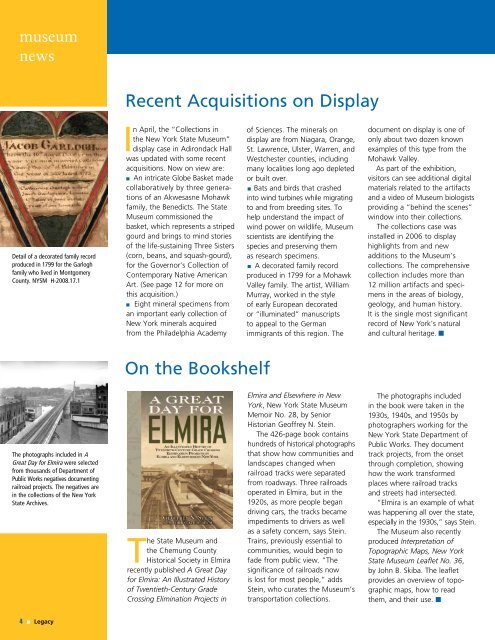Distinctly Dutch - New York State Museum
Distinctly Dutch - New York State Museum
Distinctly Dutch - New York State Museum
Create successful ePaper yourself
Turn your PDF publications into a flip-book with our unique Google optimized e-Paper software.
museum<br />
news<br />
Recent Acquisitions on Display<br />
Detail of a decorated family record<br />
produced in 1799 for the Garlogh<br />
family who lived in Montgomery<br />
County. NYSM H-2008.17.1<br />
In April, the “Collections in<br />
the <strong>New</strong> <strong>York</strong> <strong>State</strong> <strong>Museum</strong>”<br />
display case in Adirondack Hall<br />
was updated with some recent<br />
acquisitions. Now on view are:<br />
n An intricate Globe Basket made<br />
collaboratively by three generations<br />
of an Akwesasne Mohawk<br />
family, the Benedicts. The <strong>State</strong><br />
<strong>Museum</strong> commissioned the<br />
basket, which represents a striped<br />
gourd and brings to mind stories<br />
of the life-sustaining Three Sisters<br />
(corn, beans, and squash-gourd),<br />
for the Governor’s Collection of<br />
Contemporary Native American<br />
Art. (See page 12 for more on<br />
this acquisition.)<br />
n Eight mineral specimens from<br />
an important early collection of<br />
<strong>New</strong> <strong>York</strong> minerals acquired<br />
from the Philadelphia Academy<br />
of Sciences. The minerals on<br />
display are from Niagara, Orange,<br />
St. Lawrence, Ulster, Warren, and<br />
Westchester counties, including<br />
many localities long ago depleted<br />
or built over.<br />
n Bats and birds that crashed<br />
into wind turbines while migrating<br />
to and from breeding sites. To<br />
help understand the impact of<br />
wind power on wildlife, <strong>Museum</strong><br />
scientists are identifying the<br />
species and preserving them<br />
as research specimens.<br />
n A decorated family record<br />
produced in 1799 for a Mohawk<br />
Valley family. The artist, William<br />
Murray, worked in the style<br />
of early European decorated<br />
or “illuminated” manuscripts<br />
to appeal to the German<br />
immigrants of this region. The<br />
document on display is one of<br />
only about two dozen known<br />
examples of this type from the<br />
Mohawk Valley.<br />
As part of the exhibition,<br />
visitors can see additional digital<br />
materials related to the artifacts<br />
and a video of <strong>Museum</strong> biologists<br />
providing a “behind the scenes”<br />
window into their collections.<br />
The collections case was<br />
installed in 2006 to display<br />
highlights from and new<br />
additions to the <strong>Museum</strong>’s<br />
collections. The comprehensive<br />
collection includes more than<br />
12 million artifacts and specimens<br />
in the areas of biology,<br />
geology, and human history.<br />
It is the single most significant<br />
record of <strong>New</strong> <strong>York</strong>’s natural<br />
and cultural heritage. n<br />
On the Bookshelf<br />
The photographs included in A<br />
Great Day for Elmira were selected<br />
from thousands of Department of<br />
Public Works negatives documenting<br />
railroad projects. The negatives are<br />
in the collections of the <strong>New</strong> <strong>York</strong><br />
<strong>State</strong> Archives.<br />
The <strong>State</strong> <strong>Museum</strong> and<br />
the Chemung County<br />
Historical Society in Elmira<br />
recently published A Great Day<br />
for Elmira: An Illustrated History<br />
of Twentieth-Century Grade<br />
Crossing Elimination Projects in<br />
Elmira and Elsewhere in <strong>New</strong><br />
<strong>York</strong>, <strong>New</strong> <strong>York</strong> <strong>State</strong> <strong>Museum</strong><br />
Memoir No. 28, by Senior<br />
Historian Geoffrey N. Stein.<br />
The 426-page book contains<br />
hundreds of historical photographs<br />
that show how communities and<br />
landscapes changed when<br />
railroad tracks were separated<br />
from roadways. Three railroads<br />
operated in Elmira, but in the<br />
1920s, as more people began<br />
driving cars, the tracks became<br />
impediments to drivers as well<br />
as a safety concern, says Stein.<br />
Trains, previously essential to<br />
communities, would begin to<br />
fade from public view. “The<br />
significance of railroads now<br />
is lost for most people,” adds<br />
Stein, who curates the <strong>Museum</strong>’s<br />
transportation collections.<br />
The photographs included<br />
in the book were taken in the<br />
1930s, 1940s, and 1950s by<br />
photographers working for the<br />
<strong>New</strong> <strong>York</strong> <strong>State</strong> Department of<br />
Public Works. They document<br />
track projects, from the onset<br />
through completion, showing<br />
how the work transformed<br />
places where railroad tracks<br />
and streets had intersected.<br />
“Elmira is an example of what<br />
was happening all over the state,<br />
especially in the 1930s,” says Stein.<br />
The <strong>Museum</strong> also recently<br />
produced Interpretation of<br />
Topographic Maps, <strong>New</strong> <strong>York</strong><br />
<strong>State</strong> <strong>Museum</strong> Leaflet No. 36,<br />
by John B. Skiba. The leaflet<br />
provides an overview of topographic<br />
maps, how to read<br />
them, and their use. n<br />
4 n Legacy
















